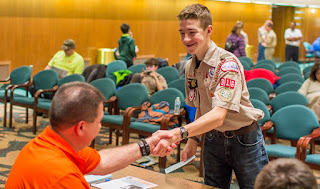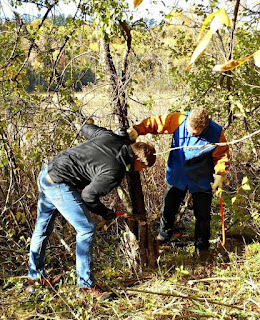“We shall overcome, we shall overcome, but what are we overcoming?” asked Maurice Willis, a student at Dr. Martin Luther King Jr. School and winner of the third and fourth grade division at the 33rd annual Dr. Martin Luther King Jr. speech contest.
He proceeded to outline challenges he sees in his community: “I know my neighborhood is not the greatest. But I know with education and determination I can make it a better place for the next generation of youth to come!”
His speech was one of 30 student speeches delivered on Dec. 3 in the Public Service Building auditorium at We Energies on the theme “We shall overcome.” Dr. King’s most notable use of “We shall overcome” was in his acceptance speech for the Nobel Peace Prize in Oslo, Norway, Dec. 10.
Portia Young of Sargento Foods was the guest emcee, introducing students in kindergarten through grade 12 who spoke on the theme. Their families, friends and teachers gathered in the auditorium to hear them present. First-, second- and third-place medals were awarded in each grade category.
Imajyne Robertson-Hodges won her division, kindergarten through second grade. She is a second-grader at Elm Creative Arts School. “My art teacher signed me up for this because she knew I could do it,” she said. “My family is so happy, and my art teacher is too! It’s a whole big thing for me!”
 |
| Imajyne Robertson-Hodges, winner of the grade K-2 division. |
From the youngest to the oldest, students tackled big issues. Racism, prejudice and violence were noted as some of the main problems students strived to overcome, both globally and in their communities. While some students were specific in combatting issues, others spoke more broadly. Many students did their research and cited statistics. Others quoted famous leaders, especially Dr. King.
“We have to learn to overcome our own issues before we take on the world,” said Maranda Brown, a senior at Eastbrook Academy, in her impassioned speech that won the 11th-12th grade division.
“When I gave my speech today, I gave it from my heart,” said Brown. “It wasn’t about the accolades or the praise or anything like that. It was telling my story and trying to get a message through: here’s my story, and here’s how you can overcome. I hope the listeners felt and heard and took heed to the words I had to say.”
Willis, Robertson-Hodges, Brown and the other students who won their divisions will give their speeches and receive awards at the 33rd Annual Dr. Martin Luther King Jr. Birthday Celebration at the Marcus Center for the Performing Arts in Milwaukee on Jan. 15, 2017.
 |
Eastbrook Academy had four winners: At top left, Maranda Brown,
first in grade 11-12 division; Ariana Cawthorn, second in grade 9-10
division. Front left, Benji Johnston, second in grade 3-4 division;
Praise Ayodabo, third in grade K-2 division. |
 |
| Finalists in grade 3-4 division from left, Jordan Cameron, Hawthorne Elementary, third place; Benji Johnston, Eastbrook Academy, second place; Maurice Willis, Dr. Martin Luther King Jr. School, first place; Elizabeth Roque-Frias, Grant School; Desiree Morris, Emerson Elementary. |



































